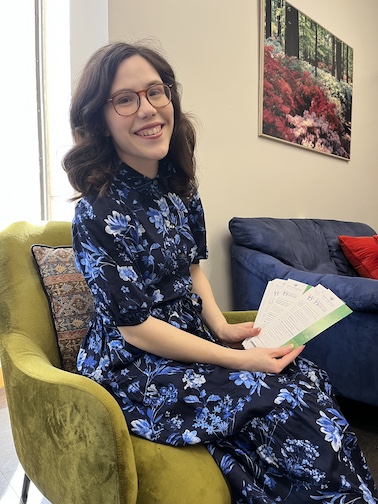
Category: Art Conservation
Student Blog: Public Engagement with the Poison Book Project
May 26, 2025 Written by Estrella Salgado
Summer Institute, the first month of the Winterthur Program in American Material Culture, is a whirlwind of visiting labs, meeting curators, and exploring the house. One of the most memorable sessions in this dizzying period featured a series of tantalizingly green tomes. The Poison Book Project immediately stood out for its unique mission of studying arsenic in Victorian bookbinding and its real commitment to public engagement. I was so impressed with the emerald green color swatch bookmarks that Dr. Melissa Tedone and Dr. Rosie Grayburn developed to assist with visual identification of arsenical green cloth — what a fantastic, affordable way to share research and encourage citizen science!

I was delighted to be hired as a Project Assistant in the fall of my second year, thanks to generous support from the Nadia Sophie Seiler Fund. Material culture and conservation are complementary programs, but of course, they have distinct curriculums, and I had not imagined that there would be a place for me on the PBP team. Per the job description, I began by mailing out bookmarks requested by institutions and professionals, an excellent education in small-scale finances and operations. Walking to the Winterthur post office with a fresh stack of envelopes always lifted my spirits, since I knew that the bookmarks would truly be helpful to our colleagues around the world. Amusingly, I even mailed a set of bookmarks to a program in Winterthur, Switzerland.
Though this task may seem straightforward, there is always a way to optimize systems. I took it upon myself to sort the shared email account with new labels, created Google Forms for both paid and complimentary institutional bookmark orders, and wrote instructions in the shared Drive for the next Project Assistant. I also thought about strategies for PBP to strengthen the mechanics that support its advocacy. I made major changes to the website, adding copy that sets an engaging, confident tone and reformatting pages to better support the user experience. On a recent episode of Antiques Roadshow Detours, screen recordings of the PBP website were shown to explain the project. It was so exciting and affirming to see how my work had been useful. Other projects this year have included preparing for development campaigns (hey, did you know you can donate here?), archiving all news stories and publications pertaining to PBP, and tracking how people are learning about PBP (leading answers: online searches and social media).
This fall, I will swap coasts to serve as the Graduate Intern in the President’s Office of the Getty Trust. I am confident that part of why my application was successful was my description of working with PBP. My goal is to move into museum administration, so having recent, demonstrable accomplishments in both traditional academia and public engagement projects made me a stronger candidate. When I move, I might have to bring a small stack of PBP bookmarks to share with my new colleagues. They are an excellent research tool, a fun conversation starter, and to me, a material tie to a role that, amidst all the challenges of thesis writing and graduation planning, reminded me of my personal mission in the field — foster good research, then go forth and share it.
-Estrella Salgado, Winterthur Program in American Material Culture, University of Delaware Class of 2025
